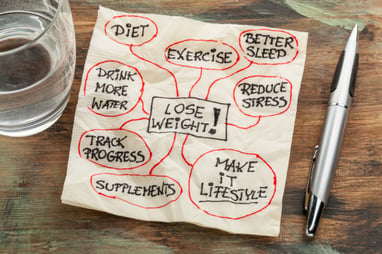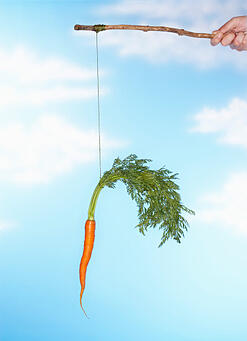 Are you excited about your progress thus far in 2020 toward those goals you set back in January?
Are you excited about your progress thus far in 2020 toward those goals you set back in January?
In a recent post, I discussed Redefining New Year’s Resolutions, and I truly hope that some of the information hit home with you when you determined your course of action this year.
So how have you fared thus far in accomplishing what you set out to do this year? If you are like most Americans, you would probably answer that question with the frowning-face emoticon. :(
Health and Fitness Goal-Setting by the Numbers
Let’s take a look at some numbers:
- Only about 4% of Americans write down their goals.
- 45% of people make new year’s resolutions.
- Only 8% of Americans will succeed in their new year’s resolutions
- Check-ins to gyms drop 10% beginning as early as February (according to a two-year Facebook study).
Unfortunately, the statistics are against us when it comes to seeing our new life solutions (if you read my earlier posts, you know I hate the word “resolutions”) come to fruition. So I ask you again: How are you doing in the first couple of months in 2020 in accomplishing those promises you made yourself?
Just like any other health and fitness assessment, it’s beneficial to reevaluate your progress in completing those things you felt were pretty important back in January. So let’s take care of some reasons for why you may not be on track to completing your yearly goals.
Reasons (or Excuses) Why Resolutions Fail: Do Any of These Sound Familiar?
- Didn’t write down your goals.
- That positive mindset you started off with has fizzled and you have traveled back to “Negativetown.”
- Went back to poor sleeping and recovery habits that snowballed into other poor behaviors because you tend to make bad choices when you are “tired and wired.”
- Maybe you didn’t see fast enough results, and during one of your negative self-talks you figured, “What’s the big deal about enjoying that third piece of cake?” Keeping with that mindset, you repeated the above.
- Don’t have enough time. (This one is my favorite!) You have the same amount of time in the week that more successful people have. So it’s not about time; it’s about prioritization. If you were to say “I suck at managing my life,” that makes a lot more sense than “I don’t have enough time.”
How Do I Get Back on Track?
Hurdles and setbacks are inevitable in anything that we hope to accomplish. The trick is to realize what is not working and do something better! Your life will not change until you change something you do on a daily basis.
- Assess your wellness and prioritize. Your overall health and wellness encompasses every aspect of your life, and each one exists in a delicate balance. With a strong structure of these aspects, you can weather any storm; but if one is out of alignment, you could topple over. Determine which aspects may need some work and focus on them.
- So maybe goal writing isn’t for you. Choose one powerful word to say to yourself every day. It works; trust me.
- Bottom line: Find a way to get 7 to 8 hours of sleep. Create a ritual and stick to it.
- Manage your time. Quick math here: There are 24 hours in a day. If you work 8 hours, and if you get 8 hours of sleep, you have 8 remaining hours. How are you spending those hours? Remove the unproductive things, such as surfing the interwebs or watching TV, and use that time working toward your goals.
- De-clutter. If your car, office, and house are full of stuff piled up all over the place, it can make managing your life much more difficult. I will give one example: If your kitchen countertops are full of stuff, how amped are you going to be to cook dinner? Clear out the junk to make room for the jewels!
- Get a workout buddy to hold you accountable, not one that will take the day off with you at the first sign of struggle. If you need one, let me know, I will be there for you!
- Binge cook: Plan your food, cook your food, and eat your own food!
Don’t let the statistics get you down. You can make 2020 great by being a better manager of your life. Reassess, realign, and reenergize yourself toward achieving your best year yet!
This blog was written by Tony Maloney, Health Fitness Specialist and Fitness Center Manager. To find out more about the NIFS bloggers, click here. This blog as been updated. Original blog was posted on Apr 21, 2015.


 In
In  The concept of defining fitness seems simple at first glance, but like Jell-O®, the definition of fitness appears solid on the surface until you grab at it and realize that impression was wrong. Both will get messy while they ooze in all directions.
The concept of defining fitness seems simple at first glance, but like Jell-O®, the definition of fitness appears solid on the surface until you grab at it and realize that impression was wrong. Both will get messy while they ooze in all directions. If you are anything like me, the new year comes with lots of “I’m going to do this (fill in the blank) better than I did last year,” or “I am starting a new workout plan for the year,” or maybe “My goal this year is to ________.” Then mid-February hits and all those New Year’s habits you planned to start, goals you were working toward, or things you were going to do better on have fallen off the radar.
If you are anything like me, the new year comes with lots of “I’m going to do this (fill in the blank) better than I did last year,” or “I am starting a new workout plan for the year,” or maybe “My goal this year is to ________.” Then mid-February hits and all those New Year’s habits you planned to start, goals you were working toward, or things you were going to do better on have fallen off the radar.
 It’s that time of year again, the time when most are bombarded with messages of New Year’s resolutions and how to
It’s that time of year again, the time when most are bombarded with messages of New Year’s resolutions and how to  Wearable fitness technology
Wearable fitness technology
 If you’re like me,
If you’re like me, 
 I’d like to take a few moments to highlight a member of the NIFS Lifestyle Program. This program provides extra guidance and observation to individuals with chronic medical concerns. NIFS’s Lifestyle Coordinator communicates with the participant’s physician about their progress and helps them plan workouts geared to their specific medical needs. Take a few minutes to read about Kim Flowers and learn how this program has changed her.
I’d like to take a few moments to highlight a member of the NIFS Lifestyle Program. This program provides extra guidance and observation to individuals with chronic medical concerns. NIFS’s Lifestyle Coordinator communicates with the participant’s physician about their progress and helps them plan workouts geared to their specific medical needs. Take a few minutes to read about Kim Flowers and learn how this program has changed her.
 Along the way, I have learned that fitness and wellness can seem quite complicated. Various mentors, self-described gurus, professors, doctors, and muscle magazines have provided us all with enough quick fixes, miracle workouts, and “sound” advice to help us become the person we want to become (and also fill an encyclopedia). Probably the best advice anyone has given me would be the old saying, “Find something you love to do, do it, and do it well.” If you do not love any form of fitness, whether it is ice hockey or
Along the way, I have learned that fitness and wellness can seem quite complicated. Various mentors, self-described gurus, professors, doctors, and muscle magazines have provided us all with enough quick fixes, miracle workouts, and “sound” advice to help us become the person we want to become (and also fill an encyclopedia). Probably the best advice anyone has given me would be the old saying, “Find something you love to do, do it, and do it well.” If you do not love any form of fitness, whether it is ice hockey or  The fall season is probably my favorite time of year. The weather is just how I like it, crisp and comfortable during the day and cool at night. The colors that arrive with the turning of the leaves are a demonstration of how creative Mother Nature can be. There is another phenomenon that takes place during this time of year that I anticipate all summer long, and that is FOOTBALL!
The fall season is probably my favorite time of year. The weather is just how I like it, crisp and comfortable during the day and cool at night. The colors that arrive with the turning of the leaves are a demonstration of how creative Mother Nature can be. There is another phenomenon that takes place during this time of year that I anticipate all summer long, and that is FOOTBALL!